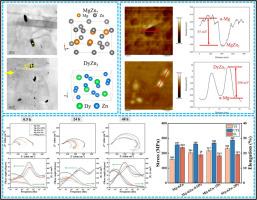为生物应用定制不同 Dy 含量的 Mg-6Zn 合金的腐蚀行为和机械性能
IF 11.2
1区 材料科学
Q1 MATERIALS SCIENCE, MULTIDISCIPLINARY
引用次数: 0
摘要
研究了合金化镝(Dy)元素对 Mg-6Zn 合金在模拟体液(SBF)溶液中的生物降解行为和机械性能的影响。结果表明,Dy 对晶粒细化有明显的促进作用,并在含 Dy 的合金中形成独特的纤维纹理。Dy 的存在促进了颗粒状 DyZn3 沉淀的形成,这种沉淀的电极电位高于基体,从而加速了基体腐蚀。腐蚀结果表明,Dy 元素不利于降低 Mg-6Zn 的初始腐蚀速率,但随着浸泡时间的延长,有利于提高产品膜的保护效果。含 Dy 的合金比 Mg-6Zn 具有更高的强度,同时还能保持良好的塑性,这与晶界和沉淀强度效应有关。因此,在 Mg-6Zn 合金中加入 2 wt.% Dy 可协同提高强度以及适度的耐腐蚀性和断裂伸长率。本文章由计算机程序翻译,如有差异,请以英文原文为准。

Tailoring corrosion behavior and mechanical property of Mg-6Zn alloy with varying Dy contents for biological application
The influence of alloying dysprosium (Dy) element on the biodegradable behavior and mechanical property of Mg-6Zn alloys in a simulated body solution (SBF) solution was studied. The results indicate that Dy significantly contributes to grain refinement, and form a distinctive fiber texture in Dy-containing alloys. The presence of Dy promotes the formation of granular DyZn3 precipitates, which possess a higher electrode potential than the matrix, thus accelerating matrix corrosion. Corrosion results demonstrate that the Dy element is not beneficial to reducing the initial corrosion rate of Mg-6Zn but is conducive to improving the protective effect of product film as the immersion time increases. Dy-containing alloys exhibit higher strength than Mg-6Zn while maintaining good plasticity related to grain boundary and precipitation strength effects. Consequently, the incorporation of 2 wt.% Dy into Mg-6Zn alloys results in a synergistic enhancement of strength, as well as moderate corrosion resistance and fracture elongation.
求助全文
通过发布文献求助,成功后即可免费获取论文全文。
去求助
来源期刊

Journal of Materials Science & Technology
工程技术-材料科学:综合
CiteScore
20.00
自引率
11.00%
发文量
995
审稿时长
13 days
期刊介绍:
Journal of Materials Science & Technology strives to promote global collaboration in the field of materials science and technology. It primarily publishes original research papers, invited review articles, letters, research notes, and summaries of scientific achievements. The journal covers a wide range of materials science and technology topics, including metallic materials, inorganic nonmetallic materials, and composite materials.
 求助内容:
求助内容: 应助结果提醒方式:
应助结果提醒方式:


